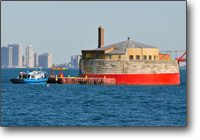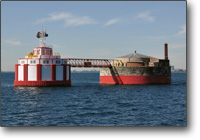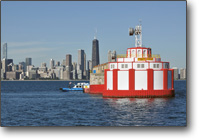Historical Information
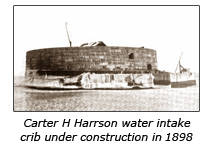 Construction
of the Carter H. Harrison water intake crib was completed in 1900.
Similar in design and construction to the Dunne crib, this new crib was
named in honor of a past Chicago Mayor - Carter Henry Harrison who
served as Chicago Mayor from 1879 until 1887. While he was re-elected
to a fifth term in the position in 1893, and was assassinated before he
could complete his term.Lying 2.1 miles
North-Northeast of Chicago Harbor Light, at the north side of the
harbor entrance, the new crib was built of stone, with the outer walls
of the dwelling and well chamber faced with hydraulic pressed brick,
and the inner walls of the well chamber and entrance hall faced with
white enameled brick. According to a contemporary report, “the living
rooms are provided with all modern conveniences.” Construction
of the Carter H. Harrison water intake crib was completed in 1900.
Similar in design and construction to the Dunne crib, this new crib was
named in honor of a past Chicago Mayor - Carter Henry Harrison who
served as Chicago Mayor from 1879 until 1887. While he was re-elected
to a fifth term in the position in 1893, and was assassinated before he
could complete his term.Lying 2.1 miles
North-Northeast of Chicago Harbor Light, at the north side of the
harbor entrance, the new crib was built of stone, with the outer walls
of the dwelling and well chamber faced with hydraulic pressed brick,
and the inner walls of the well chamber and entrance hall faced with
white enameled brick. According to a contemporary report, “the living
rooms are provided with all modern conveniences.”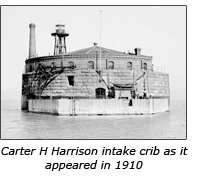 Capped
with a Silver gray lantern on red skeleton pyramidal tower, an
acetylene burner was surrounded by a red glass chimney within the 300
mm lens to provide a characteristic single red flash every 3 seconds.
As was the case with all the cribs, the fog signal was made on a bell
with automated striking mechanism which rang the crib’s characteristic
group of 3 strokes every 30 seconds. Showing
signs of age after only thirty years, plans were already underway to
replace the Harrison crib with a new structure by 1930. Capped
with a Silver gray lantern on red skeleton pyramidal tower, an
acetylene burner was surrounded by a red glass chimney within the 300
mm lens to provide a characteristic single red flash every 3 seconds.
As was the case with all the cribs, the fog signal was made on a bell
with automated striking mechanism which rang the crib’s characteristic
group of 3 strokes every 30 seconds. Showing
signs of age after only thirty years, plans were already underway to
replace the Harrison crib with a new structure by 1930.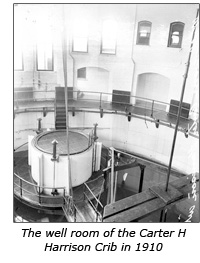 That
new structure was to be the William E. Dever crib, again named for
Chicago Mayor William Emmett Dever who served from 1923 to 1927 and
left is stamp on the city in the way of a massive series of public
works initiated during his administration. The new Dever Crib was
erected alongside the Harrison in 1935. The main vertical component of
the structure was built of reinforced concrete, and stood in 32 feet of
water. Beneath this central shaft, the vertical shaft continued down to
a depth 190 feet below lake level to connect with the horizontal tunnel
to the pumping station. The 75 foot diameter steel well house was
fabricated onshore, and on completion was floated out to the site in
the tow of tugs in much the same way as Chesbrough’s first timber crib
had been towed into the lake almost 60 years previous, and installed
atop the central concrete column. After construction was complete, the
light was relocated from the skeletal tower on the Harrison crib to the
apex of the higher roof of the new structure. That
new structure was to be the William E. Dever crib, again named for
Chicago Mayor William Emmett Dever who served from 1923 to 1927 and
left is stamp on the city in the way of a massive series of public
works initiated during his administration. The new Dever Crib was
erected alongside the Harrison in 1935. The main vertical component of
the structure was built of reinforced concrete, and stood in 32 feet of
water. Beneath this central shaft, the vertical shaft continued down to
a depth 190 feet below lake level to connect with the horizontal tunnel
to the pumping station. The 75 foot diameter steel well house was
fabricated onshore, and on completion was floated out to the site in
the tow of tugs in much the same way as Chesbrough’s first timber crib
had been towed into the lake almost 60 years previous, and installed
atop the central concrete column. After construction was complete, the
light was relocated from the skeletal tower on the Harrison crib to the
apex of the higher roof of the new structure. 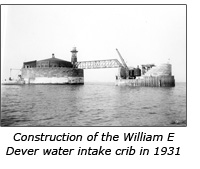 With
the Dever crib fully functional, the Harrison crib was taken out of
operation in 1936. However, this was a situation that was not to last.
As water requirements in the city continued to grow, the Harrison crib
was reactivated some time thereafter. The light on the Dever crib was
replaced with a quick-flashing white light powered by electricity in
1976, and an automatically operated modern diaphragm fog signal
installed. The aging Harrison crib was again removed from service in
1998 after the tunnel system below caved-in when it was de-watered for
an inspection. With
the Dever crib fully functional, the Harrison crib was taken out of
operation in 1936. However, this was a situation that was not to last.
As water requirements in the city continued to grow, the Harrison crib
was reactivated some time thereafter. The light on the Dever crib was
replaced with a quick-flashing white light powered by electricity in
1976, and an automatically operated modern diaphragm fog signal
installed. The aging Harrison crib was again removed from service in
1998 after the tunnel system below caved-in when it was de-watered for
an inspection.

Seeing
this Light 
Because
all of Chicago's intake cribs are located in the lake beyond the
breakwater system, only very distant views can be obtained from
anywhere on shore and a private boat or charter boat represent
the most realistic way to view these structures. Both the
Great Lakes Lighthouse Keepers Association and the United
States Lighthouse Society offer infrequent tours of the suth end of
Lake Michigan, both of which have always provided great close-up views
of this and the other water intake cribs.
GPS coordinates: 41°54'58.02"N x 87°34'20.12"W
Refrence sources
Annual reports of the City of Chicago Department of Public Works, various
Great Lakes Light Lists, various
|
